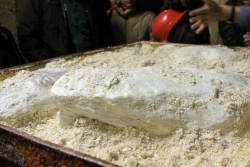Ecomuseo delle Miniere e della Val Germanasca
Useful Information
| Location: |
Località Paola, 10060 Prali TO.
(44.925365, 7.066124) |
| Open: |
Mid-MAR to JUNE Fri-Sun, Hol 9:30-12:30, 13:30-17. JUL to mid-SEP Mon, Wed-Sun, Hol 9:30-12:30, 13:30-17. Mid-SEP to NOV Sat, Sun, Hol 9:30-12:30, 13:30-17. ScopriMiniera: 10:30, 14:30. ScopriAlpi: 10, 14. Checkin at least 45 minutes before the tur. [2022] |
| Fee: |
ScopriMiniera:
Adults EUR 16, Children (6-17) EUR 13.50, Children (3-5) free, Disabled EUR 13.50, Family (1+1) EUR 24. Groups (25+): Adults EUR 13.50, Children (6-17) EUR 11, Disabled EUR 11. ScopriAlpi: Adults EUR 16, Children (8-17) EUR 13.50, Children (3-7) free, Disabled EUR 13.50, Family (1+1) EUR 24. Groups (25+): Adults EUR 13.50, Children (6-17) EUR 11, Disabled EUR 11. Both: Adults EUR 26, Children (8-17) EUR 21. [2022] |
| Classification: |
 Talc Mine Talc Mine
 Rock Mine Rock Mine
 Écomusée Écomusée
|
| Light: |
 Electric Light Electric Light
|
| Dimension: | |
| Guided tours: |
ScopriMiniera:
D=2 h, MinAge=3. ScopriAlpi: D=3 h, MinAge=8.  for groups after appointment:
for groups after appointment:


|
| Photography: | allowed, no selfie sticks, tripods or flash |
| Accessibility: | no |
| Bibliography: |
A. Borghi, P. Cadoppi, A. Porro, R. Sacchi (1985).
Metamorphism in the North part of the Dora-Maira Massif (Cottian Alps)
Bollettino del Museo Regionale di Scienze Naturali di Torino, 3, 369-380.
A. Borghi, R. Sandrone (1990): Structural and metamorphic constraints to the evolution of a NW sector of the Dora-Maira Massif (Western Alps) Memorie della Società Geologica Italiana, 45, 135-141. |
| Address: |
Ecomuseo delle Miniere e della Val Germanasca, Località Paola, 10060 Prali TO, Tel: +39-0121-806987.
E-mail: |
| As far as we know this information was accurate when it was published (see years in brackets), but may have changed since then. Please check rates and details directly with the companies in question if you need more recent info. |
|
History
| 2021 | multimedia and interactive section of the museum enhanced financed by the Compagnia di San Paolo Foundation. |
Geology
The valley is part of the crystalline core of the Alps, with marbles, micaschist, gneisses and rare metabasite. This structure is called Dora-Maira Unit. Embedded in the rocks are separate deposits of talc which were mined for the soft, heat-resistant rock. The surrounding marble was also mined in the valley.
Description

The Ecomuseo delle Miniere e della Val Germanasca (Ecomuseum of Mines and the Germanasca Valley) is a mining museum located in former mine buildings at the road through the Val Germanasca, a side branch of the The ecomuseum has an exhibition space of 150 m² with exhibitions of the geological history of the earth and 3D representations of the mining basin. There are numerous remains of mining, tools, machinery, but also personal items, photographs, documents, and art. The outdoor space is used for heavy machinery and is the station of the mine train.
The visit to the museum is completed by an underground mine tour into Miniera Paola (Paola Mine) which is called ScopriMiniera (DicoverMine). It takes two hours and includes a ride with the mine train, which brings the visitors deep into the mine. Here is the place where the talc was mined and some of it can still be seen in the walls. The mine requires a jacket and a rain jacket or windbreaker, the ride on the train is otherwise due to the cold wind very uncomfortable. Good walking shoes are also necessary, hard hats are provided.
The Val Germanasca (Germanasca Valley) was the home of the Waldenses, a religious movement founded in 1173 by the Lyon merchant Petrus Valdes, also known as Peter Waldo. They were rather extreme in their beliefs and preached apostolic poverty, that’s why they became known as the "Poor Men of Lyon" They were prosecuted, and resisted rather massive mobbing, finally many returned to the catholic church. Those who did not were confronted with organized and massive discrimination for centuries. In the 16th century, the Waldensians were absorbed into the Protestant movement. Although they were nearly annihilated in the 17th century, they still exist today, mostly in valleys of the Piedmont region of Northern Italy, the French Alps and in Argentina. After World War II they united with the Methodist Church. One of their strategies was to go to rather remote valleys like this, and use them as a sort of hideout.
The valley is also famous for the Occitan language which is spoken here. Also known as lenga d’òc or Provençal it is spoken in Southern France, Monaco, Val d’Aran in Spain and a few valleys in northern Italy. It is also very similar to Catalan, which was considered a sort of dialect, at least until the late 19th century. It’s a so-called Romance language, which means it is based on Latin. Switzerland and northern Italy have numerous valleys which speak their own language, for example Rhaeto-Romance languages. They are not official languages but there is some support, like bilingual schools. Both topics, the Waldensians and the Occitan are important aspects of the history of the valley and are explained in the museum.
The 30 km long valley is named after the river Germanasca, a right affluent of the Chisone. It begins at more than 3,000 m asl and ends at 600 m asl, so it is rather narrow and steep. In former times the valley was also named Val San Martino (Valley of Saint Martin).
 Search DuckDuckGo for "Ecomuseo delle Miniere e della Val Germanasca"
Search DuckDuckGo for "Ecomuseo delle Miniere e della Val Germanasca" Google Earth Placemark
Google Earth Placemark Ecomuseo delle Miniere e della Val Germanasca, official website (visited: 18-MAY-2022)
Ecomuseo delle Miniere e della Val Germanasca, official website (visited: 18-MAY-2022) Index
Index Hierarchical
Hierarchical Countries
Countries Maps
Maps